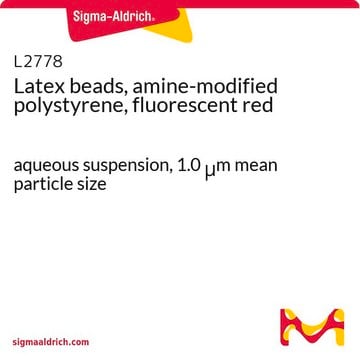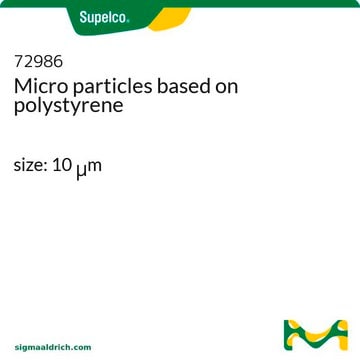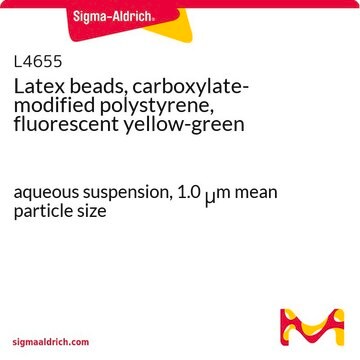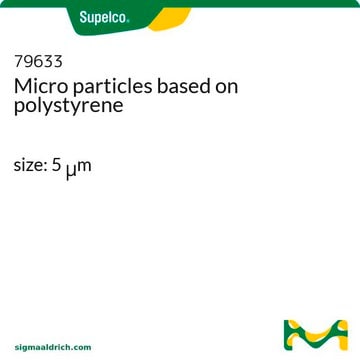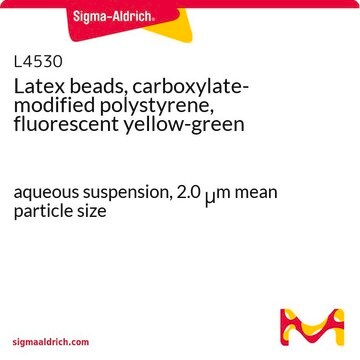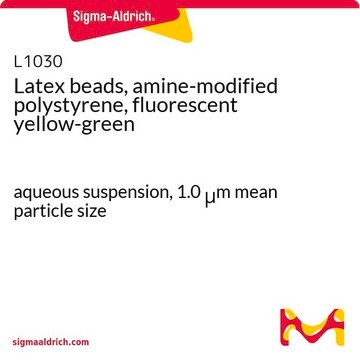LB11
Latex beads, polystyrene
1.1 μm mean particle size
Synonym(s):
Latex Microspheres, Polystyrene Beads, Polystyrene Microspheres
Sign Into View Organizational & Contract Pricing
All Photos(1)
About This Item
Recommended Products
form
aqueous suspension
composition
Solids, 10%
packaging
pack of 1 mL
pack of 15 mL
pack of 2 mL
mean particle size
1.1 μm
Looking for similar products? Visit Product Comparison Guide
General description
Latex bead suspensions mostly contain polymer particles and water. It includes small amounts of surfactant, sodium bicarbonate, and potassium sulfate. Polystyrene microparticles are stabilized colloidal particles bearing a negative charge. Polymerization of styrene under certain conditions results in spontaneous coalescent bead formation leading to the formation of microparticles.
Application
Latex beads, polystyrene have been used:
- in phagocytosis experiments
- to provide a stimulated condition for adjusting the neutrophil count in cell suspension
- to incubate macrophages for phagosome trafficking assays
Biochem/physiol Actions
Latex beads (polystyrene) are used in electron microscopy, cell counter calibration, antibody-mediated and agglutination diagnostics.
Storage Class Code
12 - Non Combustible Liquids
WGK
WGK 3
Flash Point(F)
Not applicable
Flash Point(C)
Not applicable
Certificates of Analysis (COA)
Search for Certificates of Analysis (COA) by entering the products Lot/Batch Number. Lot and Batch Numbers can be found on a product’s label following the words ‘Lot’ or ‘Batch’.
Already Own This Product?
Find documentation for the products that you have recently purchased in the Document Library.
Customers Also Viewed
Irene Martínez De Toda et al.
The journals of gerontology. Series A, Biological sciences and medical sciences, 75(10), 1827-1833 (2019-10-20)
Several parameters of immune function, oxidative, and inflammatory stresses have been proposed as markers of health and predictors of longevity and mortality. However, it is unknown if any of these parameters can be used as predictors of survival in centenarians.
Christin Neuber et al.
Clinical hemorheology and microcirculation, 61(2), 291-299 (2015-09-28)
Survivors of Hodgkin's disease as well as of breast and lung cancer are at risk of radiation-associated cardiovascular disease. Recent studies demonstrated a correlation between cardiovascular risk factors and circulating endothelial microparticles (EMP) and thereby suggest increased EMP levels in
Sabna Rajeev Krishnan et al.
Neoplasia (New York, N.Y.), 18(1), 25-32 (2016-01-26)
The confinement of multiple myeloma (MM) to the bone marrow microenvironment requires an invasive bone marrow biopsy to monitor the malignant compartment. The existing clinical tools used to determine treatment response and tumor relapse are limited in sensitivity mainly because
Nisha Singh et al.
PloS one, 8(1), e53442-e53442 (2013-01-18)
Leishmania silently evades host immune system and establish in the hostile environment of host macrophage phagolysosomes. For differentiation, growth and division parasite acquires divalent cations especially iron from the host nutritive pool. Natural resistance associated with macrophage protein1 (NRAMP1), a
Courtney K Brock et al.
Nature communications, 10(1), 1044-1044 (2019-03-07)
Epithelial tissues require the removal and replacement of damaged cells to sustain a functional barrier. Dying cells provide instructive cues that can influence surrounding cells to proliferate, but how these signals are transmitted to their healthy neighbors to control cellular
Our team of scientists has experience in all areas of research including Life Science, Material Science, Chemical Synthesis, Chromatography, Analytical and many others.
Contact Technical Service
